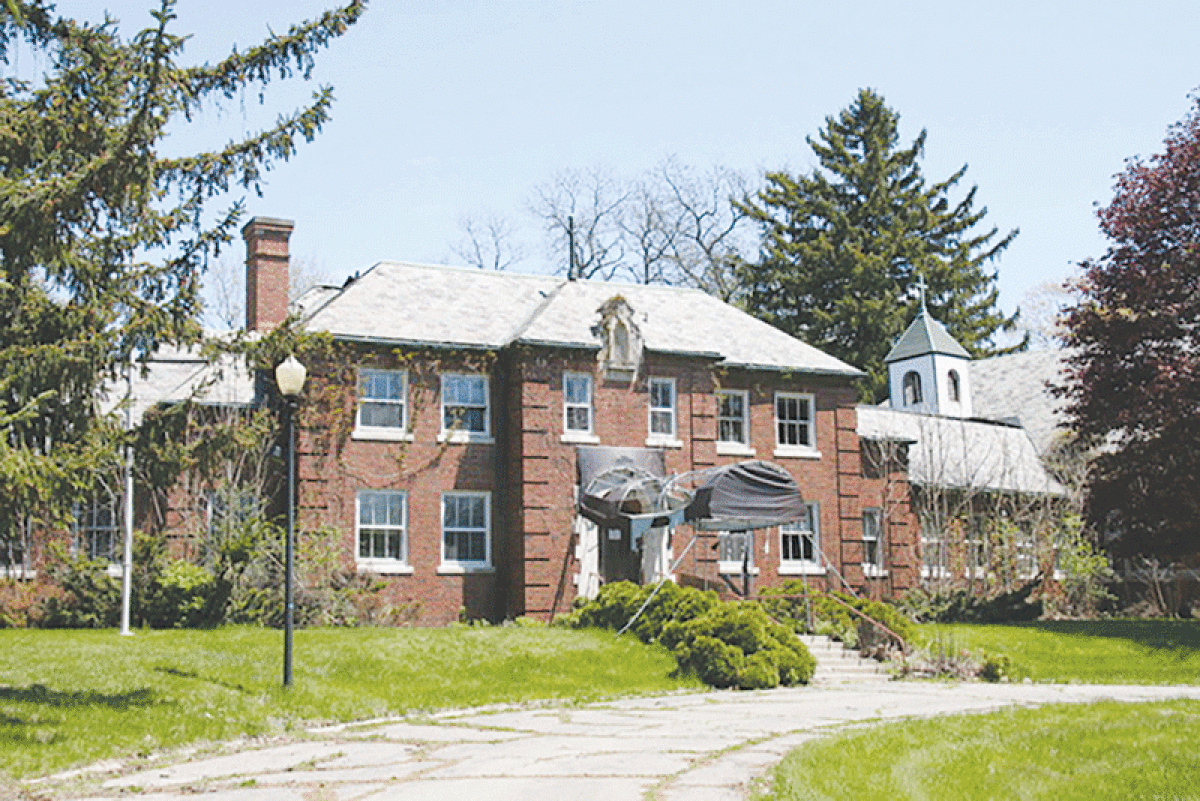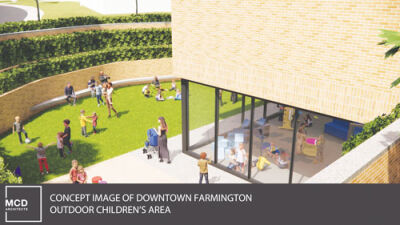FARMINGTON HILLS — A property that holds a special place in the hearts of some local residents may begin to see redevelopment as soon as this year.
The St. Vincent and Sarah Fisher Center was located on the northwest corner of 12 Mile and Inkster roads for approximately 75 years before relocating to Detroit more than 15 years ago.
Since then, the center, which housed mothers and children in need, has been vacant.
Cottages, a playroom and a chapel are all a part of the history of the center, located on more than 31 acres.
The property, which is owned by Evangelical Homes of Michigan, has had “several” development proposals over the years, according to Farmington Hills City Council member Valerie Knol.
She said some of the proposals have gotten as far as Farmington Hills’ Planning Commission, but there have been challenges in bringing a development proposal to fruition.
“This site has to go before the Historic District Commission. … it’s a historic site,” Knol said. “Unfortunately, it’s a difficult site to redevelop due to the grade of the site and the topography — there is water on the site, and the site has a drop-off on it, so it’s not a flat site. So it makes it more difficult to redevelop.”
Despite saying that it is a “very challenging site to develop,” Raj Patel, who is the owner and CEO of Optalis Healthcare, made an offer on the property and said, “Later this year, we plan on breaking ground on this.”
Patel did not disclose the purchase offer.
“There’s always a contingency until you see a building,” he said. “The proposed development will happen under what’s called the planned unit development. … Essentially, what a PUD is, is specific, targeted zoning for a site. … We’re doing a mixed-use here.”
Optalis is a skilled rehabilitation facility, and Patel said that his company develops buildings for rehabilitation and nursing homes in several markets, including southeast Michigan.
The plan is for Optalis to occupy the south part of the property. But with the property being so large, a co-developer is also in the mix.
Robertson Brothers develops condominiums, which are expected to go on the north side of the property.
“Optalis Healthcare is purchasing the site from the current seller,” Patel said. “They’re selling us the entire site … and then Optalis is going to sell, then, in turn, a portion of the site to Robertson Brothers. … We don’t need the whole 30 acres, so I’m selling what I don’t need to them.”
At a regular meeting last August, the Farmington Hills City Council approved the development proposal, with five City Council members in favor of it and Mary Newlin opposed.
At the meeting, Charmaine Kettler-Schmult, who is the director of planning and community development for Farmington Hills, stated that the city’s Planning Commission recommended unanimous approval for the development project in July.
Patel shared details about Optalis’ part of the proposed development.
“We are going to develop the southern half of the site; (it) will be a single building, 100-room skilled nursing and rehabilitation center,” he said. “It will be a state-of-the-art facility — probably one of the better ones in southeast Michigan — and it will be a great addition to Farmington Hills’ health care infrastructure.”
Tim Loughrin is the director of land acquisition for Robertson Brothers, and he said their part will occupy about 15 acres.
“We did get approved from the Planning Commission (and) the City Council, and we’re negotiating on a PUD development agreement for 64 townhomes — three-story townhomes and 30 detached condominium single-story ranches. So, it’s kind of a mix of those two products,” Loughrin said.
The townhomes are expected to be between 1,300 and 1,600 square feet, with the detached ranches being around 1,850 square feet.
Although Loughrin, who chose not to disclose a purchase price, said that there are potential modifications with the plan coming in the next couple months, the hope is to get started on land development sometime this year.
“We build as we sell, typically, so I’d guess we’d probably be building about … 30 to 40 homes a year,” he said. “So that would take us, probably, about three years to build out — three to four years.”
At the City Council meeting last August, Newlin shared her reason for opposing the development project.
“It’s not a good look for the city to have a nursing home on every single corner. I know you say it’s rehab, but it’s a nursing home,” Newlin said. “For me, it still doesn’t bring to the city what I think we need, which is families. I don’t see a place where children go out to a yard (and) play. … If it was all homes, it’d be one thing, but I’m not supportive of this nursing home on this corner.”
In response to Newlin’s comments, Patel said, “This facility is not an assisted-living facility. This is a skilled nursing facility.”
A resident voiced some concerns about the project during the public comments portion of the City Council meeting.
“You do not have eco-friendly accreditation,” she said of the development. “I’m not real savvy to all of this, but I know that it’s using or not using environmentally friendly materials and appliances when you build your structures. … I think that this council should not let the ink on the rubber stamp be used. I think you need to find out more clarification on the side that’s rehabilitation versus the side that’s going to be homes, because it looks like to me you’re using Optalis Healthcare as a shield to just build houses there.”
Farmington Hills Mayor Vicki Barnett responded to those comments.
“The material that will be used for building these projects will be recaptured from the developments that they’re taking down in order to put this up. … There is no shielding; this has been a very open process along the way,” she said. “I can assure you that this has not been rubber-stamped. … What you’re seeing tonight is the final iteration, maybe, of a project that has been multiple years, multiple meetings, both between planning and City Council, the neighbors, the neighborhood, and our engineering department.”
Farmington Hills resident Cynthia Lietz shared some thoughts about the development proposal via a text message.
“It saddens me to even think that Sarah Fisher would be something other than what the original founders sole purpose and desires were for that location,” she stated. “The founders were the Daughters of Charity and their vision was to help orphaned children, the sick and the destitute. They started with only $8.50, a lot of prayer, and they moved mountains. My prayer is for someone to pick up the baton and finish the race.”
Knol said that the latest plan has made it through the Historic District Commission, the Planning Commission and the City Council.
She said that the Historic District Commission required that the chapel that is located on the property be preserved.
“So the developer is going to restore the chapel. … It’s going to be connected to the skilled rehab,” Knol said. “This chapel will be restored, and it can be used as a gathering space for the nursing staff to hold meetings in there; family members coming to visit their family, their loved ones that are in there for rehab, can use this space as like a reflection room for a quiet space … kind of a multi-purpose gathering space. … And also, they are going to work with the Historic District Commission to honor the significance of the Sarah Fisher home, so … they’re still working on this plan, but the idea is that they could include artwork, photographs or descriptive information about the Sarah Fisher home for girls, and they could include that into this chapel, which is going to be used as kind of a reflection room or a multi-purpose room.”
Knol also said that the Historic District Commission is requiring the developer to reuse, “as much as possible,” materials and sculptures that are on the site.
“You wouldn’t want to use those on the homes or the short-term skilled nursing facility, but they could use those, for example, (as) signage if they build some sort of block for the signage to go on, or they could be used in a decorative walkway,” she said. “Also, there could be walking paths with some artwork … and they could use some of these historic sculptures or materials that they’re able to preserve in some of these outdoor amenities throughout the property.”
Knol said that the proposed development is an example of a good partnership, which involved Optalis, Robertson Brothers, the Planning Commission, the City Council and the Historic District Commission.
“And of course, the neighbors, because there’s a single-family residential neighborhood just to the east of this property, and they were very active and involved in this process,” she said. “With numerous meetings with all the different, interested stakeholders, I think we were able to come to a good development. … I think, ultimately, with everyone compromising, all these different parties … we’re going to end up with a high-quality development that’s realistic.”
Farmington Hills City Council member Ken Massey said that he is glad that things have gotten to a point “where we seem to be moving forward.”
“It was the … Historic District Commission meeting with the developer, City Council representatives and Planning Commission representatives that were able to kinda talk through what could be allowed, what could happen, and I think they came to a good consensus, and that has to actually be recognized,” Massey said. “There were a series of meetings to talk through where the challenges existed and how could we overcome the challenges, because each group has their own rules.”
One of Knols’ roles for the Farmington Hills City Council is to serve as the liaison to the Historic District Commission.
“So I was kind of involved with this from two angles — from being the liaison for the Historic District Commission, as well as being on City Council,” she said.
Patel credited Knol with being an “ally in facilitating the dialogue between the city and us.”
“What we’re trying to do is accomplish what you could call, essentially, threading multiple needles at the same time, and I think we’ve found that delicate, fragile balance that took us 2 1/2 years working with the city, the Planning Commission, (and) the City Council — several iterations of design changes and so forth to kind of find all the boxes getting checked,” Patel said. “Everybody had a seat at the table, and we found what I would call the perfect project for this site that checks all the boxes. … We’re pretty excited to see it through; not at the end of the road yet, but close.”
Patel anticipates that it could take a couple of years to build the skilled rehabilitation facility.
“We have opportunities for the public to revisit it as we restore it, almost like a park-style feel,” he said.
Knol said that community members have inquired about what is going on with the site “numerous” times and that it is satisfying to have made progress.
“It’s beneficial in a couple different ways. First of all, a vacant, dilapidated site is going to be turned back into productive use and will be attractive once again,” she said. “And additionally, it will provide needed housing — the ranch detached condos are in demand; you have a lot of … baby boomers and seniors that live in this community that like ranch-style housing. … And then additionally, it’s tax revenue for the city, so by turning the site into a productive use again, (it) helps with the tax base and the community.”
Knol is not interested in having a historic site sit vacant, and she is pleased that the process that has been started could lead to a positive resolution.
“Ideally, I think it’s a really good outcome when you can preserve the historic building — rehab it and preserve it — but also find an adaptive use for it, so that it’s relevant in today’s society and we can get people in the historic building,” she said. “Right now, no one can see the chapel; no one can see anything on the Sarah Fisher site — I mean, it’s gated off. It’s closed. It’s shut down. … By putting it back into productive use, it accomplishes a variety of goals, so I think that’s a win-win.”
Kettler-Schmult also weighed in on the development.
“(The) property has been vacant for a very long time,” she said. “It’s always a concern with the community having resources that are not being utilized. It would be tremendous for the community having new assets at that location. … What’s there now, quite a bit of it will be taken away and has deteriorated over time.”
Patel referred to the site as one that is “near and dear” to a lot of people.
“We feel like it’s gonna be a win-win for the city, for us, the community, and we’re looking forward to (getting) this over the finish line,” he said.
Evangelical Homes did not respond to requests for comment by press time.
 Publication select ▼
Publication select ▼
























